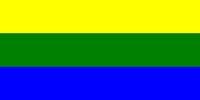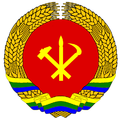Democratic People's Republic of Urbonia
This article refers to a micronation or element of micronationalism which is defunct and no longer exists. You can help make the article reflect that or ask on the talk page for further information. |
Democratic People's Republic of Urbonia
Demokratikong Republikang Popular ng Urbonia | |
|---|---|
Constituent State | |
| Motto: The People's Republic Does What It Is Determined To Do | |
| Anthem: The Urbonia of Daikoku | |
| Country | |
| Established | February 21, 2013 |
| Admission into the Daikoku Federation | April 13, 2013 |
| Capital | Tou-gun |
| Government | |
| • Type | Constituent state, parliamentary republic |
| • President | Migs Caldeo |
| Area | |
| • Total | 41.99 km2 (16.21 sq mi) |
| Population (2013) | |
| • Total | 14 |
| • Rank | 2nd |
| Demonym | Urbonian |
| Time zone | GMT +8 |
The Democratic People's Republic of Urbonia (Filipino: Demokratikong Republikang Popular ng Urbonia), abbreviated as DPRU, or more commonly known as Urbonia, is a constituent state of the Daikoku Federation located in the southern region of the country. Its seat of government is located at Tou-gun and it borders the Principality of Treisia to the north, and Seidaikei to its northwest. It has a population of 14 and it covers an area of 41.99 square kilometers.
The micronation was initially a presidential republic called the People's State of San Andreas which was established on May 7, 2012 by the country's first president, Migs Caldeo, and later it became the Democratic People's Republic of Urbonia on February 21, 2013 following a violent coup d'etat.
Urbonia, along with the Principality of Treisia, became one of the two constituent states of the Daikoku Federation on April 13, 2013, following the founding of the federation by the two constituent states through the Treaty on Unification and the Creation of a Federal State.
Etymology
Urbonia came from the Esperanto word "urbon" which meant urban and it was added to the Latin suffix "-ia", which literally meant "land of urban".
The former name of the country, San Andreas, is the Spanish translation for St. Andrew, and its origins can be traced back to the video game, Grand Theft Auto: San Andreas, where much of the planning for the creation of the micronation took place.
History
People's State of San Andreas
The People's State of San Andreas was a territorial micronation with territories in the Philippines, Europe, Southeast Asia and North America. It was a presidential constitutional republic founded on May 7, 2012, with Co-President Migs Caldeo as its president, with the People's Assembly being its legislature.
The People's State era was filled with many achievements, such as the nation's first general elections in June, the national space program, the rapid increase of its population, and the increase of political activity in the nation, as well as several hardships, such as dispute with the Grand International Micronation in May, the collapse of its civilian government in June, war with Rostyland in July and several attacks against the state and its president.
On January 2013, President Migs Caldeo and the National People's Party won the second general elections held in the country, and this resulted into the transition of the country to the Democratic People's Republic of Urbonia, which was a parliamentary republic.
Democratic People's Republic of Urbonia and Operation Nadeko
In January 2013, President Migs Caldeo had announced that San Andreas would enter into a transitional period to the Democratic People's Republic of Urbonia through the Dissolution Act. The act placed the entire country under the supreme leadership of the President and detailed how the transition process would be carried out. It also stated that the transition to the new country would end on May.
The transition period, however, was plagued by violence as a coup orchestrated by dissident members of the People's Assembly and by the People's Security Force was carried out on February 21 after they became dissatisfied with the nation's policy of not having an armed forces. The coup plotters installed General Vince Tambaoan as president.
President Caldeo, in return, declared the early establishment of the DPRU on the same day, and vowed to defend his government, the legitimate government of the republic.
On February 22, 2012, the coup plotters surrendered and agreed to the ultimatum of the government. The two sides began negotiations on the creation of a new government on the same day, but negotiations between the government and the coup plotters soon deteriorated as the coup plotters launched another coup.
President Migs Caldeo was not able to stop the coup since most of the government had participated in the coup. He called on Grand Prince Karlos Luis Mozo Anioay of the Principality of Treisia and other micronations in order to bring an end to the coup.
President Caldeo and Grand Prince Anioay orchestrated a counter-coup which was called Operation Nadeko. It involved a simultaneous attack by loyal Urbonian forces and the Treisian Internal Defense Force headed by Margrave Jeremy Celespara on the city of Shiro-shi, the capital of the Urbonian republic. Operation Nadeko was launched on February 28, and it resulted in the surrender and arrest of the coup plotters.
After the coup, the Urbonian republic desperately tried to rehabilitate the nation and the government, with a new constitution signed on March 6 and the installment of Patrick Nuguid as prime minister. Prime Minister Nuguid, however, failed to create a new government and resigned on March 21. He was succeeded by Prime Minister Noel Cabe, but he too failed to create a new government.
The failure to create a new government convinced President Migs Caldeo to create a federal state between Urbonia and Treisia. He entered into secret negotiations with Grand Prince Karlos Luis Mozo Anioay in early April to form the Daikokusian Federation.
Daikoku Federation
On April 13, 2013, a summit was held between the leaders of the Democratic People's Republic of Urbonia and the Principality of Treisia, and it resulted with the signing of the Treaty on Unification and the Creation of a Federal State. The treaty formally established the Daikoku Federation with President Migs Caldeo and Grand Prince Karlos Luis Mozo Anioay being the heads of states as members of the Federal Executive Commission, and Urbonia and Treisia becoming constituent states of the federation.
On May 7, 2013, the Urbonian government was finally merged with the Daikoku Federation.

